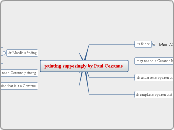Instrumental Analysis
AES
Generally low-viscosity soln.
Moderately expensive instrument
Flame test
light emitted through split
through prism
E-spectrum
Flame atomises metals.
(converts ions -> atoms)
Each element is unique
dist. of electrons from nucleus
diff no of protons in nucleus
no. of occupied shells can be diff.
AAS
Analyte needs to be metals
Sample is sprayed into flame
Atoms being analysed that are present in the flame absorb some radiation
Amount of light absorbed indicates the quantity of the element in the original sample
Each element has a unique absorption spectrum
Elements analysed need own light
source that emits the correct wavelength
Called a hallow cathode lamp
Usually measures [] of elements.
i.e, [] of mercury in fish
Extremely sensitive
Very versatile, able to
detect over 70 elements
Most of widely used of modern
instrumental techniques
UV-Vis Spectroscopy
Low molecular mass & and it
has to be an organic molecule
Mainly used for determining the []
of a substance in sample
i.e, determining the level of nutrients
in water and foods
Have to select specific wavelength
which strongly absorbs the comp. but not other comp. in sample
Arise when photons have enough energy
to move electrons from low energy to high energy level
NMR Spectroscopy
Very expensive to buy & operate
Has to be organic molecules
Carbon-13 NMR
n+1 rule shows the num.
of Carbon the actualy carbon is adjacent to
Area under the peak = ratio of C13 enviro
num of peaks = num of C13 enviro
H1 NMR
When an external
magnetic field is applied to the protons spin state, they align either
against (high energy) or with (low energy) the field.
The can move between energy levels by emitting or absorbing radio waves
Thus protons in diff. enviro
absorb different frequencies
Peaks are split by the n+1 rule
This shows the number of protons
the hydrogen is adjacent to
Area under peak = ratio of Hydrogen enviro
Chemical shifts are measured
relative to (TMS).
i.e, the furthest peak on the right
num of peaks = num of H enviro.
Identifies the structure of
molecules using radio waves
Infrared Spectroscopy
- Moderately expensive
- Requires a trained technician
Analyte has to be of organic molecules.
i.e, ethanol
Most useful for qualitative analysis
Fingerprint or elucidation of structure
Can be detected due to the bonds in the molecule absorbing the infrared
Diff. bonds will absorb diff.
wavelengths of infrared
Each peak represents a bond
Can identify the bond through
the use of the data booklet
Chromatography
based on the principle of different rates of adsorption and desorbption to and from mobile and stationary phase
It is the separation of mixtures
TLC
Uses Retention Factor (Rf)
Poor precision & accuracy
Cheapest method of chromatography
Spots visible if coloured or
under UV light
Concentrated solution is applied
at base rises by capillary action
Gas Chromatography
Sample must be easily converted
into a gaseous form
Sample must be volatilized
without breaking down
Mobile Phase is an inert gas.
i.e, Nitrogen
Most Sensitive type of chromatography.
i.e, Able to detect as little as 10^-12g
Detected by heat absorption
and retention time is recorded
HPLC
LIMITATIONS
Sample must be soluble in the solvent
Best to use Medium to High Molecular Mass Organic compounds as analytes
Mobile phase is a liquid.
i.e, could be water+ethanol
Components detected
by UV
Sensitive type of analysis.
i.e, Used to check purity of drugs.









